5.0 Recommendations for New Motorcycle Concept development and use of a New Interface Concept (NIC):
Simply scroll down or click on a link below to go straight down to it:
5.1 Torso-Arms-Handlebar Concept Development Recommandation, for technicians, engineers and industrial designers.
5.2 Trends and New Motorcycle Concept examples.
5.3 Further analyses and reactions to the new concepts above.
5.4 Development of a New Interface Concept (NIC) for steering with a rider’s torso held by seatbelts.
5.5 New 2-Wheeler concepts steering problem solved by the NIC mechanism.
5.1 Torso-Arms-Handlebar Concept Development Recommandation, for technicians, engineers and industrial designers:
2019-04-25 Version:
Use the new Torso-Arms-Handlebar theory to:
– Imagine new, better and more functional 2-Wheeler steering concepts.
– Analyze such concepts with the right understanding and parameters required to make sure these concepts work correctly and safely.
– And consider the use of a revolutionary New Interface Concept (NIC).
5.2 Trends and New Motorcycle Concept examples:
In response to the actual strong consumer trend toward electric vehicles, 2-Wheeler manufacturers around the globe actually work hard to come up with their own electric motorcycle, such as these from BMW, Harley and Yamaha:

These ‘standard’ electric motorcycles do not offer much rain and trafic accident protection, which is why many New Motorcycle Concepts have appeared in an effort to increase safety and comfort of motorcycles, lower down dynamic drag of bicycles, or simply bring up new esthetical designs:

The Honda Elysium shown above left offers a windshield and a rollover protective structure.
The BMW-C1 shown above right adds a backrest and seatbelts to increase rider protection.

The Ecomobile-Peraves-eTracer shown above left hads a closed cabine around the rider to protect against rain and cold temperatures, while reducing aerodynamic drag.
And lots of recumbent bicycles have appeared to reduce aerodynamic drag while increasing rider power output, as above right.
Rider-machine steering relationship of these New Motorcycle Concepts:
The Honda Elysium does not directly modify this relationship, since the rider sits on the front seat as normally, and grabs the steering handlebar also normally.
And the recumbent bicycle does modify this relationship, since steering levers are used instead of a normal handlebar. But it can readily be steered by leaning the torso while pushing-pulling on these steering levers, which will do the same job as a handlebar through the Torso-Arms-Handlebar/Levers mechanism.
New users of both the Honda Elysium and the recumbent bicycle, though, must be warned (a) that there may be a certain learning curve before being capable of riding such 2-Wheelers, and (b) that the long wheelbase increases minimum stable speed (With and without hands on the handlebar-levers) and impairs slow speed stearability.
On the other hand, both the BMW-C1 and the Ecomobile-Peraves-eTracer do modify the rider-machine steering relationship directly: The rider’s torso may be immobilized against the backrest of these BMW-C1 and Ecomobile-Peraves-eTracer, which also have seatbelts and shoulder restraints that may further immobilize rider torso.
5.3 Further analyses and reactions to the New Motorcycle Concepts above:
The BMW C1 was undoubtedly mechanically and aesthetically well designed and able to protect its rider in case of frontal collisions. Riders did not have to wear an helmet in Germany. And BMW designers and engineers must certainly be tributed for this.
But it was not accepted as such everywhere. For instance, the Motorcycle.com article BMW C 1 CityScooter – The Meek Shall Inherit the Earth summed up in 1999 that:
Whatever the Europeans decide on, you can bet that if one ever washed up on American shores, it will be known simply as “that goofy looking scooter thing.
Another example illustrates that the BMW C1 might have not been perceived as easy to steer:
In the SPY comedy, by Paul Feig with Rose Byrne, Melissa McCarthy and Jason Statham , USA 2015, a beginner-secret-agent lady tries to chase the bad guys using a BMW C1. Agent Susan Cooper (Melissa McCarthy) gets on it and drives away in (A) below. But she immediately falls on a side as in (B)… with her foot out as in (C), and she says in (D) (in the french version): “What’s the idea of putting a roof on a scooter, you’re not the Pope”:

Still another example of new 2-Wheeler concepts not being easy to steer, is given in a November 4, 2010 Peraves.Wordpress post by Stefano Paris.
Paris writes about the MonoTracer that:
Last Thursday (October 28th, 2010) Los Angeles Times‘ vehicle expert Susan Carpenter had the privilege of experiencing the phenomenal Peraves E-Tracer and MonoTracer for her first time.
… Stefano Paris was their freeway wingman piloting the all electric AC Propulsion powered X PRIZE winning E-Tracer.
… A new rider needs to acclimate to the counter-steering control because unlike a motorcycle, one is sitting reclined and can’t lean one’s body to “steer” the vehicle. …
(Author archives for Stefano Paris)

More can be learned about this example of a new 2-Wheeler concept not being easy to steer, as given in the November 13, 2010 Los Angeles Times article and related video, by Susan Carpenter herself:
E-Tracer is for those who like a challenge and YouTube – Susan Carpenter meets the E-Tracer

Carpentor wrote about it in her article:
“It’s not a hybrid. … ” said Roger Riedener, the Swiss chief executive who dreamed up the idea and who walked away with $2.5 million in September for winning the 2010 Automotive X-Prize Alternative Class. Beating 127 other X-Prize entries competing to build the world’s most fuel-efficient vehicle, the E-Tracer can travel more than 200 miles on a single gallon of gas equivalent and reach a potential top speed of 200 mph.
Wow! Can’t we help exclaim.
But she added:
Stepping into the cockpit to ride solo, I closed the door and strapped in. Making sure the drive switch was in the forward position, I rolled on the throttle gaining speed, toggled the outriggers up — and promptly fell over, damaging my training wheels in the process. …
Learning to drive the E-Tracer is no easy feat.

So for both Paris and Carpentor, uneasiness characterizes steering of new 2-Wheeler concepts.
And they both touch a crucial point here:
It’s obvious from the Torso-Arms-Handlebar Theory, it’s Supporting evidence and its comparison with Other known steering theories, that a rider MUST lean right-or-left to steer his 2-Wheeler THROUGH the Torso-Arms-Handlebar mechanism.
So there’s no wonder why the BMW C1 and the Ecomobil-Peraves Mono-Tracer or E-Tracer, all have steering problems, with their backrest and seatbelts limiting rider leaning.
Still furthermore, a word of caution must be given for the case where a BMW-C1 or E-Tracer rider:
– Stops at a street light before turning left (or right in England or Australia),
– Holds his 2-Wheeler straight-up at standstill,
– Suddenly decides to start fast and turn before a car coming in the opposite direction in front of him,
– Leans swiftly towards the side where he wants to go,
– And then gets blocked by the safety belts and backrest.
The rider may then be surprised, may ‘freeze’ for a fraction of a second, and may get hit by that incoming car.
The conclusion is that special concern must be given and special mechanisms must be developed for new 2-Wheeler concepts to fully offer their outstanding capabilities.
It’s precisely what has led to the following New Interface Concept (NIC) below:
5.4 Development of a New Interface Concept (NIC) for steering with a rider’s torso held by seatbelts:
In order to increase rider comfort and safety within the limits of 2-Wheelers, it is essential to develop a steering system that will still be functional with a rider’s torso held by seatbelts in a rollover protective structure.
We have worked on such special steering mechanisms over the last 50 years. The Torso-Arms-Handlebar theory has been essential to analyze these systems and orient development in order to finally come up with a functional steering system.
The main steps of this development are shown below. They illustrate that development of such novel steering systems are not easy but may be feasible. So other people may turn out to repeat this achievement for their own benefit:
A) A first ‘success’: The leaning handlebar-front-suspension-and-front-wheel-assembly research prototype.
It was felt that when riding a motorcycle at ‘fair’ speeds like 65 KPH (40 MPH), the chassis did not seem to lean when the rider leant his torso towards where he wanted to go. So it was thought that it was the front wheel gyroscopic reactions that held the 2-Wheeler up, permitted the torso to lean sideways and then permitted the 2-Wheeler to lean towards the same side as the rider, in order to go into the turn.
So it was thought that the handlebar-front-suspension-and-front-wheel-assembly could have a pivot at the lower-front portion of the chassis, in order for this assembly to stay up due to the front wheel gyroscopic reactions, while letting the seatback and roll cage lean with the torso in the direction where to go into the turn. Testing beats theory, so this had to be tested. But our limited budget only permitted in 1973, the “research prototype” shown below, that was a downhill coaster using some old Honda 750 parts.
Now let’s not forget that it’s when looking at an ugly burnt rubber garbage, that Charles Goodyear ended up with his invention of Vulcanisation that permitted existence of all of today’s durable tires.
Well, even as crude as what’s shown on this image below, this research prototype had a similar lightening effect when put together to test a steering system.
Hard to believe as it may seem, this prototype led to the Torso-Arms-Handlebar mechanism and a Better 2-Wheeler steering theory, for both bicycles and motorcycles. This theory explaining many phenomena better than all previous theories, including the countersteering theory most popular among motorcyclists, but virtually unknown to road AND mountain bicyclists who keep on riding day in, day out.
It’s also hard to believe that this theory has lead further later on, to the development of a mechanism, the New Interface Concept or NIC (French acronym – Nouvelle Interface de Conduite. German acronym – Neue Interface Konzept), that drastically eases the steering of backrest and protective-structure equipped 2-Wheelers. More on this NIC further down below.
Furthermore, ugly and crude as nothing else can be and although the underlying logic now appears false in the light of the Torso-Arms-Handlebar theory, this research prototype worked, in the sense that it could be ridden (or driven).
B) The next failure: The wrongly acting front wheel prototype.
Using the newly born Torso-Arms-Handlebar theory, it was well understood that the relative sideways movement of the torso to the handlebar, controlled the handlebar. It was further thought that the handlebar itself could rather be laterally shifted and aimed in the same direction where to go, in order to act similarly as a car-steering-wheel and be shifted laterally in the same direction as the car’s front wheels, in the direction where to go. In terms of theoretical servomechanism theory, it looked like a great invention:

This was done by having the handlebar shifted, leaned and turned to the right by the TAH mechanism. BUT the handlebar was loose on its vertical support and had no effect on the front wheel. And it’s rather the vertical support itself alone, which was shifted by leaning to the right and which oriented the front wheel to the left, thus inverting its orientation: Handlebar shifted and turned to the right, but support shifted-leaned to the right, which oriented the front wheel to the left. Similarly as Destin Sandlin’s 2015 Backwards Brain Bicycle.
In servomechanism terms, it’s obvious that the error detector would give an inverted signal, which will fool the mechanism, as explained in sub-section 2.9 Crossing hands on the handlebar of page 2.0 Supporting Evidence of my web page: https://dynamik23.com/home-2/2wheels/proofs/#Crossing-hands-on-the-handlebar
So it was NOT a great invention. It was rather a total failure. It only took two 5-10 second trials to find out that it was impossible to hold it up. The reason was that you rather react by using your hands grabbing the handlebar, to save yourself and throw your torso in the correct direction, while pushing the handlebar in the opposite and wrong direction. So we unknowingly inverted the servomechanism feedback loop, which made it totally unstable… Throwing to garbage in an instant, an investment in parts and a few work weeks.
C) The next ‘success’: The leaning handlebar prototype.
Why lean all the front wheel and suspension assembly, when you only need to lean the handlebar around an axis at the lower-front portion of the chassis:
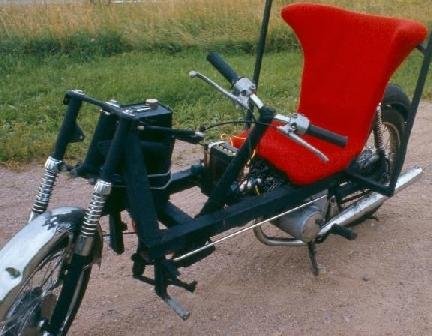
This prototype worked great and a Canadian patent was granted for it. But the vehicle was still crude and the low-horizontal pivot of the handlebar increased the wheelbase and length, making the prototype (a) harder to keep up at slow speeds and (b) using more ground space.
D) The next failure: The no-effect handlebar prototype.
It was thought that having the handlebar slide on rails above the rider’s knees would reduce the wheelbase. It did as can be seen:
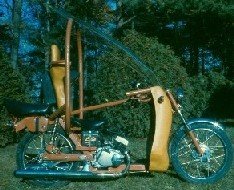
But it turned out that when moving the handlebar sideways, both arms acted as the two A-arms of a car front suspension, where the car front wheel leans little when going up or down. So the prototype’s front wheel simply kept straight ahead when the handlebar was fully moved to the right or left. So the 2-Wheeler was not unstable per se, but it was totally ‘un-steerable’.
E) The next success: The super-simple mechanism prototype.
Quite a few more years of thinking and testing based on this theory, finally brought us to the development of an ‘ultra simple’ steering mechanism, the New Interface Concept (NIC), that eases the steering of 2-Wheelers equipped with a seat-back, seat-belts and a protective enclosure.
The image below shows the ‘dunkey’ on which many special mechanisms (hence many chopped-up parts and other artefacts) have been tested:

A demonstration of this astoundingly simple steering mechanism mounted on this ‘dunkey’, was captured on an 8mm film.
This NIC is patentable and cannot be disclosed here fully, but the animation below shows how this 2-Wheeler was easy to steer in a tight parking lot course:
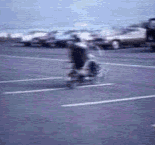
F) The following success: A more aesthetic prototype.
Although the model below is small and ‘crude’, it is remarkable in that it integrated this NIC (New Interface Concept) 20 years before introduction of the Honda Elysium and BMW C1, while offering the same basic functional and aesthetic elements:
– Seat with backrest (plus seatbelts not shown),
– Side hip-protection in case of the 2-Wheeler falling and sliding sideways on the road,
– Forward protection in case of forward collision,
– While all the elements avoid looking like prison-window-bars, and rather support an impression of being ‘opened’ and act to psychologically and subconsciently suggest a mother’s arms letting her baby go forward towards exploration and freedom.
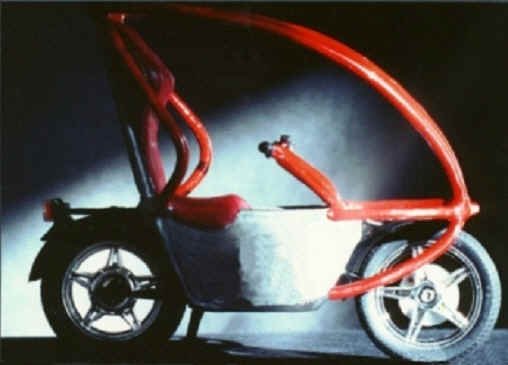
5.5 New 2-Wheeler concepts steering problem solved by the NIC mechanism:
Standard no-protection electric motorcycles are already available on the market.
But as of now, production of the rain-and-trafic-protecting gas-engine BMW C1 has been stopped and a BMW equivalent electric motorcycle has been developed, but has not made it to mass production – to the best of our knowledge. The same goes for the EcoMobile-Peraves-eTracer, Mono-Tracer and X-Tracer.
But it’s absolutely possible that this situation could evolve with the NIC and supporting Torso-Arms-Handlebar Theory. The safer, lower-cost and more fuel-or-electric efficient New Motorcycle Concepts would certainly benefit from:
– The regain of interest that a new steering concept could raise,
– The ease to learn to ride it,
– The fun to ride it more easily,
– The safety benefits that both the vehicle and the application of the theory would bring.
– And the economic and environmental benefits that such concepts offer.
Both an Electric BMW C1 and an X-Prize winner EcoMobile-Peraves-eTracer such as below, would definitely benefit from being equiped wiht this patentable NIC. They could then definitely break the glass ceiling and become the leap towards affordable and efficient electric vehicles, that so many people dream of right now:


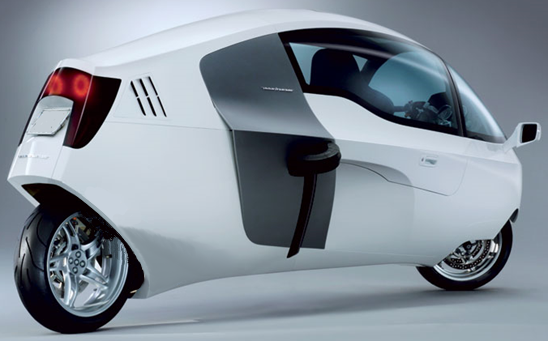

Pierre M. Ethier, Mechanical Engineer.
Member of the Ordre des Ingénieurs du Québec
LinkedIn profile: Master Degree in motorcycle dynamics from Laval University, Quebec
Novel 2-Wheeler and 3-Wheeler concept designer for over 45 years.
Pierre Ethier may be pronounced “Pee-Air . A-Tee-A” to get you closer to the French pronunciation.
